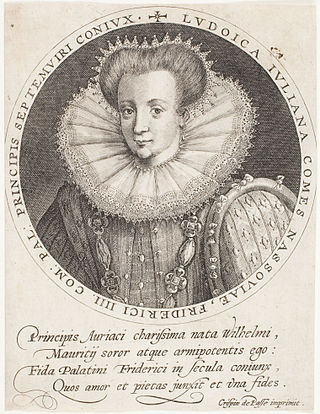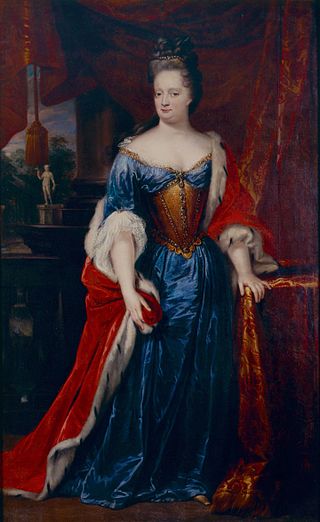
Maria Catherina van der Linden-Swanenburg was a Dutch serial killer who murdered at least 27 people and was suspected of killing more than 90 people.

Princess Carolina of Orange-Nassau was a Dutch regent. She was the daughter of William IV, Prince of Orange, Stadtholder of the Netherlands, and Anne, Princess Royal. She was regent of the Netherlands from 1765 until 1766 during the minority of her brother, William V.

Catherine of Guelders, was regent of the Duchy of Guelders between 1477 and 1492. First for her brother during his absence, and then for her nephew.
Catharina is a feminine given name, the Dutch and Swedish spelling of the name Catherine. In the Netherlands, people use a great number of short forms in daily life, including Carine, Catelijne, Cato, Ina, Ineke, Kaat, Kaatje, Karen, Karin, Katja, Katrien, Katrijn, Kitty, Nienke, Rina, Tineke, Tiny, Toos, Trijn, Trijntje, and many others. People with the name include:

Louise Juliana of Orange-Nassau was a countess consort of the Palatinate by marriage to Frederick IV, Elector Palatine, and took part in the regency government of her son between 1610 and 1614. She also acted as a mediator between the king of Sweden and the elector of Brandenburg in 1631.

Catharina Belgica of Nassau was a countess of Hanau-Münzenberg by marriage to Philip Louis II, Count of Hanau-Münzenberg. She was regent of Hanau-Münzenberg during the minority of her son from 1612 until 1626.

Countess Elisabeth of Nassau was the second daughter of prince William of Orange and his third spouse Charlotte of Bourbon, and Duchess of Bouillon by marriage to Henri de La Tour d'Auvergne. She was the regent of Sedan during the absence of her spouse; between 1623 and 1626 during the minority of her son; and from 1632 during the absence of her son.

Henriette Catherine of Nassau was princess consort of Anhalt-Dessau by marriage to John George II, Prince of Anhalt-Dessau, and regent of Anhalt-Dessau from 1693 to 1698 during the minority of her son Leopold I, Prince of Anhalt-Dessau.

Henriëtte Amalia Maria von Anhalt-Dessau was a Princess consort of Nassau-Dietz.

Elisabeth Wandscherer was a Dutch Anabaptist.
Maria was a Curaçaoan slave and leader of a slave rebellion on Curaçao in the Dutch West Indies in 1716.
Henri Lodewijk George "Ody" Koopman was a Dutch tennis player.

Cornelia Catharina de Lange was a Dutch pediatrician and neuropathologist who along with Winfried Brachmann first described the eponymous Cornelia de Lange syndrome.

Catharina Josepha Pratten was a German guitar virtuoso, composer and teacher, also known as Madame Sidney Pratten.
Catharina Besselman (1678-1702), was an influential Dutch colonist in the Dutch East Indies. She was famous for her unconventional lifestyle and the conflict between her spouse and the church which was caused because of it.
Catharina Johanna Koek (1763–1843), was a Dutch governor's wife. She is depicted in history as a typical example of the Dutch colonial customs in Dutch East Indies and how it was viewed by Europeans.
Catharina Herman was a Dutch heroine of the Eighty Years' War. She was hailed in history as a role model of marital fidelity.
Catharina de Chasseur also known as Catherine le Sasseure and Catherine Dechassoir, was a Dutch counterfeiter. She was the central figure of a famous criminal court case which has often been referenced in Dutch literature.
Lijsbeth Kuijper (1778–1828), was a Dutch shipowner.
Catharina Petit (1660–1740) was a Dutch stage actor.










